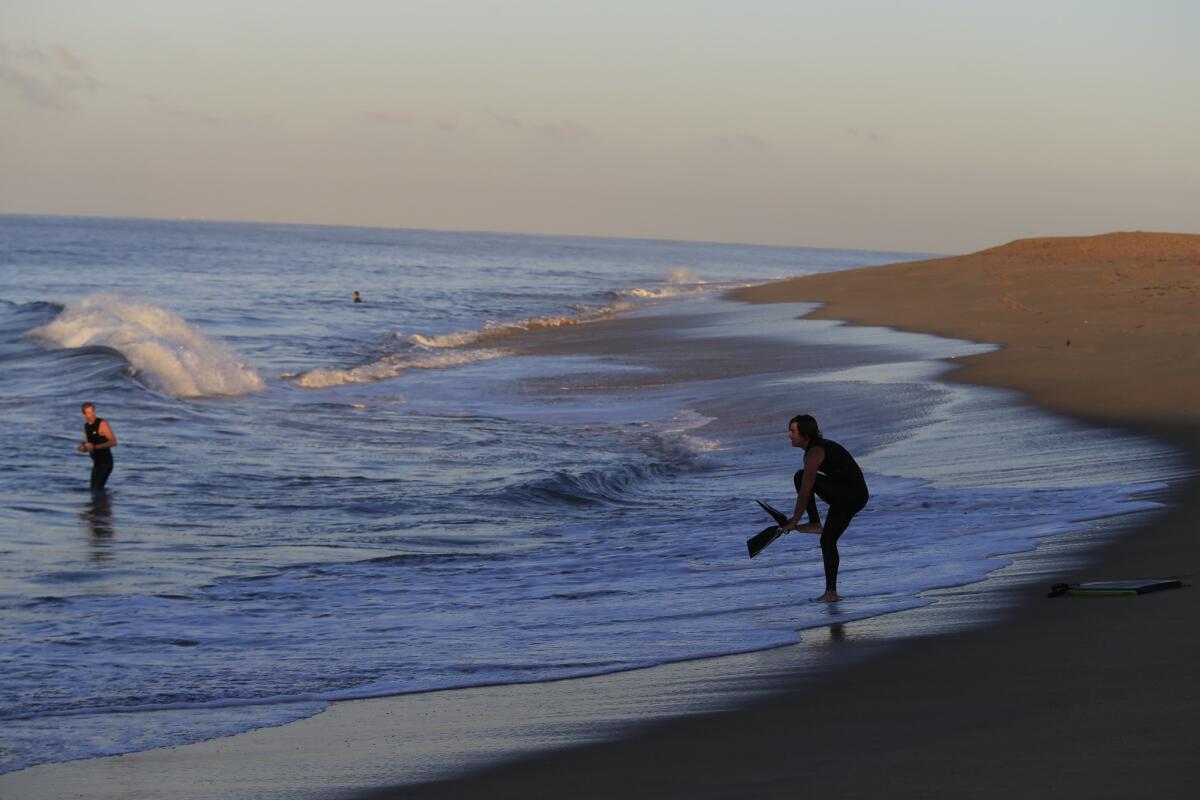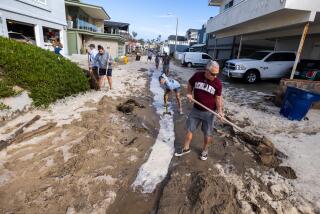Tsunami surge could help experts predict future ocean events

A body boarder gets ready to enter the surf at The Wedge in Newport Beach Harbor Thursday morning. A tsunami surge from a huge earthquake in Chile hit the Southern California coast causing tide fluctuations of up to a foot.
Though Thursday’s tsunami surge had little impact on most Southern Californians, for those who track such events, it offered a chance to hone their craft.
“As far as predictability, this one behaved pretty well,” said National Weather Service meteorologist Mark Jackson. “It’s just as important to accurately predict these tsunamis as it is to forecast the 2011 tsunami. They’re all very important.”
In 2011, following a deadly earthquake off the northeast coast of Japan, tsunami waves brought 6- to 8-foot surges that flooded beaches and harbors, splintered docks, crushed scores of boats and triggered evacuations of residents near shore. One person died, and marinas and harbors up and down the coast saw extensive damage.
See the most-read stories this hour >>
A major earthquake off the Chilean coast triggered Thursday’s tsunami advisory for the California coast, though the resulting surge was no higher than 13 inches, Jackson said.
“Just because this one likely won’t produce much damage doesn’t mean we shouldn’t be paying attention,” he said.
Thursday’s tsunami advisory extended from San Onofre State Beach in San Clemente, about 55 miles north of San Diego, to Ragged Point, about 50 miles north of San Luis Obispo, according to the National Tsunami Warning Center.
In anticipation of dangerous currents, the Orange County Sheriff’s Department announced that all beaches, harbors and marinas would be closed. They were reopened at 6 a.m.
The Ventura County Sheriff’s Department urged residents to use “extra caution” around beaches and instructed mariners to use additional prudence in the morning.
In Chile, the powerful earthquake was followed by at least three aftershocks above magnitude 6, according to the U.S. Geological Service.
Those along Chile’s Pacific shore, from Puerto Aysen to Arica, were ordered to evacuate and seek higher ground.
The National Weather Service said that for Hawaii, the initial wave of the tsunami would arrive at 3:11 a.m. local time. A major tsunami was not expected for Hawaii, but sea level changes and strong currents could pose a hazard to swimmers and boaters, as well as others near the shore. The threat could continue for several hours after the first wave hits, the weather service said.
In recent years, powerful earthquakes have struck other parts of the Pacific Rim, generating tsunamis that have proved deadly after arriving in California.
“Not only are we in the ring of fire, we face the ring of fire,” Jackson said.
Some of the most common earthquake epicenters are in Chile, Japan, Alaska and the Aleutian Islands.
“It just depends on how strong those earthquakes might be,” Jackson said.
A magnitude 8.8 earthquake rocked Chile on Feb. 27, 2010, with tsunami waves as high as 3 feet arriving in Santa Barbara and Santa Cruz, according to data compiled by the state Department of Conservation. Currents reached speeds of up to 15 knots, or about 17 mph, far above the 8-knot threshold needed for currents to damage piers and harbors.
The following year, on March 11, 2011, a tsunami set boats loose and damaged 20 docks in Ventura Harbor. Shelter Island in San Diego also reported significant damage.
After the 8.3 magnitude temblor hit Chile on Wednesday, tsunami waves of 15 feet were observed at Coquimbo, Chile, while Valparaiso and Quintero saw waves of about 6 feet. Between 3- and 10-foot waves could arrive in French Polynesia. Waves between 1 foot and 3 feet were possible along some coasts in Mexico, Ecuador, Japan, Russia and New Zealand.
For breaking news in California, follow @JosephSerna and @MattHjourno.
Times staff writer Rong-Gong Lin III contributed to this report.
ALSO:
California wildfires death toll rises to 5
What is El Niño bringing us besides rain? Hammerhead sharks, experts say
A high-speed rail from L.A. to Las Vegas? China says it’s partnering with U.S. to build
More to Read
Start your day right
Sign up for Essential California for news, features and recommendations from the L.A. Times and beyond in your inbox six days a week.
You may occasionally receive promotional content from the Los Angeles Times.








